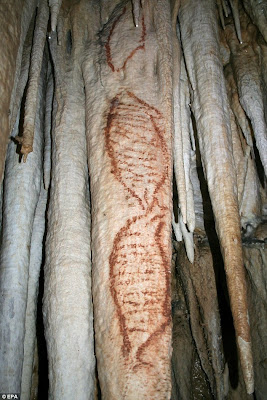Dipinti rupestri vecchi 42 mila anni trovati in Spagna. Arte dei Neanderthal?
 La grotta di Nerja, situata a 50 km da Malaga (Spagna) sarebbe il più antico museo del. Lo sostengono i ricercatori dell'Università di Córdoba, guidati da Jose Luis Sanchidrian, dopo aver effettuato la datazione delle tracce organiche rinvenute nei disegni che compaiono su alcune stallatiti. L'età compresa fra 43.500 e 42.300 anni fa coincide con l'epoca in cui le grotte erano abitate dai Nenaderthaliani. Finora la più antica opera d'arte conosciuta erano gli animali disegnati 32 mila anni fa a Chauvet (Francia): cavalli, mammuth, gufi, rinoceronti, leoni, orsi, cervi, renne.
La grotta di Nerja, situata a 50 km da Malaga (Spagna) sarebbe il più antico museo del. Lo sostengono i ricercatori dell'Università di Córdoba, guidati da Jose Luis Sanchidrian, dopo aver effettuato la datazione delle tracce organiche rinvenute nei disegni che compaiono su alcune stallatiti. L'età compresa fra 43.500 e 42.300 anni fa coincide con l'epoca in cui le grotte erano abitate dai Nenaderthaliani. Finora la più antica opera d'arte conosciuta erano gli animali disegnati 32 mila anni fa a Chauvet (Francia): cavalli, mammuth, gufi, rinoceronti, leoni, orsi, cervi, renne.Nella grotta di Nerja, sede della stalagmite pià grande del mondo (32 metri), in precedenza erano stati rinvenuti resti organici datati 24.480 anni, L'area compresa tra Nerja e Gibilterra è considerata l'ultima zona abitata dagli uomini di Neanderthal prima della loro estinzione, avvenuta 37 mila anni fa.
Neanderthals used ochre much earlier than previously thought (Archaeology News Network, January 24, 2012)
Use of red ochre by early Neandertals (Published online before print January 23, 2012. PNAS February 7, 2012 vol. 109 no. 6 1889-1894). Wil Roebroeksa, Mark J. Siera, Trine Kellberg Nielsena, Dimitri De Loeckera, Josep Maria Parés, Charles E. S. Arps, and Herman J. Müchere
Abstract
The use of manganese and iron oxides by late Neandertals is well documented in Europe, especially for the period 60–40 kya. Such finds often have been interpreted as pigments even though their exact function is largely unknown. Here we report significantly older iron oxide finds that constitute the earliest documented use of red ochre by Neandertals. These finds were small concentrates of red material retrieved during excavations at Maastricht-Belvédère, The Netherlands. The excavations exposed a series of well-preserved flint artifact (and occasionally bone) scatters, formed in a river valley setting during a late Middle Pleistocene full interglacial period. Samples of the reddish material were submitted to various forms of analyses to study their physical properties. All analyses identified the red material as hematite. This is a nonlocal material that was imported to the site, possibly over dozens of kilometers. Identification of the Maastricht-Belvédère finds as hematite pushes the use of red ochre by (early) Neandertals back in time significantly, to minimally 200–250 kya (i.e., to the same time range as the early ochre use in the African record).



Commenti